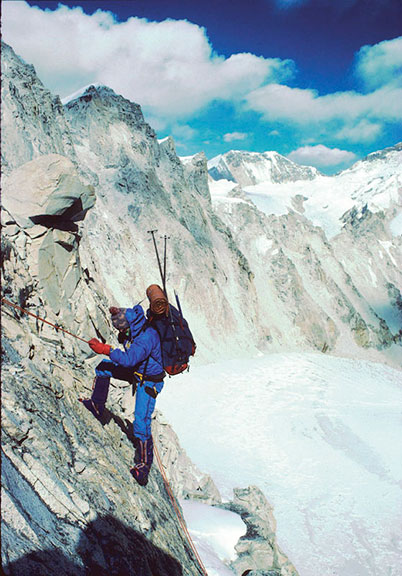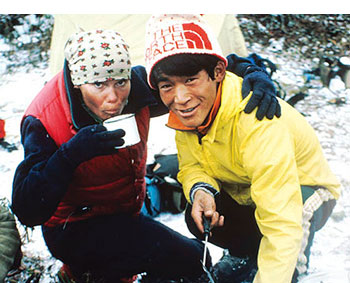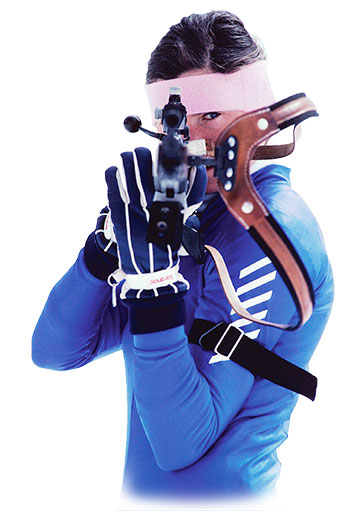| Adventurer Jan Reynolds says Women Have More than They Think | |
| by Sarah Galbraith | |
Jan Reynolds, of Stowe, Vermont, has always been one of the guys, from growing up on a dairy farm with six siblings, to participating in male-dominated mountaineering expeditions, to parenting two sons. But it was through being one of the guys, she says now, that she learned what it is to be a woman. An author of 17 books for children and adults, Reynolds’ 2013 work, High Altitude Woman: From Extreme Sports to Indigenous Culture; Discovering the Power of the Feminine (Inner Traditions) chronicles her lifelong career of mountaineering and biathlon adventure. In college she helped lead the UVM women’s Nordic ski team to a 1978 Division I National Championship, and she spent time on a women’s biathlon team. She held the women’s high altitude skiing record and was part of a team that flew a hot-air balloon over Mt. Everest, setting the altitude record there, too. She has been a member of expeditions to China, Tibet, Nepal, New Zealand, Australia, Lapland, the Amazon Basin, Canadian Arctic, Mongolia and the Sahara. She has most often been in the company of male teammates, but was also exposed to the men and women of indigenous cultures, such as the Tibetans, Sami, Tuareg, Kurds and Kirkiz. She began to recognize important differences between men and women. Her observances are shared as anecdotes within her stories of great adventure, supported by fascinating findings from current social science. Reynold’s latest book hit my desk at the perfect time. I am expecting my first child very soon and had asked myself, how would I continue to participate in the male-dominated worlds of long-distance backpacking, mountain biking and backcountry skiing, while also cultivating my new role as mother and homemaker? This book showed me that it’s possible and that my strength as a woman is that I can do both.
|
|
While Reynold’s stories of high altitude expeditions are an exciting way to bring these differences between men and women to light, you do not need to be an outdoor enthusiast to appreciate them. Her observations apply to any scenario in which men and women work together, whether at home, in politics, in sports and recreation or professionally.
Thankfully, this is not a story of men and women hailing from different planets, which was my fear when I first picked up Reynold’s book. Refreshingly, it’s a look at how men and women complement each other and how our behaviors are expressions of the same humanity. Said Reynolds in a recent conversation with Vermont Woman, “One point of the book is to create awareness. Men and women have different responses to situations, and if we’re aware of that, we can create better harmony.” She used the reaction of men and women to stress as an example. While men experience “fight or flight” responses, it was only recently discovered that women under stress react in a biochemically different way. In fact they react to stress with what has been called a “tend and friend” response. Reynolds wrote in her book, “Women alleviate stress through bonding, while men may experience more stress because they tend to compete with each other.” Reynolds now uses her understanding of the differences between men and women in professional lectures, such as a recent multimedia presentation to the Vermont National Guard, where teamwork between men and women is of vital importance. “We’ve been trained to see ourselves as women in a men’s world,” she said in her message to them. But her experience taught her that women are hardly unfit. Reynolds believes that effective cooperation across gender is a matter of playing to each of our strengths. She wrote in her book, “It is through understanding these differences that we will be empowered to take advantage of them and put them to good use.”
Her first expedition, described in her book, didn’t end according to plan. The Southern Cross Expedition in the heart of the New Zealand Alps took a route that had never been done on skis before. Then in her early twenties, Reynolds was the fourth in a team with three men, one, her boyfriend, Ned Gillette. She was not allowed to carry a map, so it was left to the men to pick routes. The men were in an unspoken race to the finish, she soon realized, and got separated from the group. She spent her last night of the trip alone in the snowy wilderness. Ironically, without a map, she got herself to their planned exit, a remote airstrip where they were to be picked up by plane. Still, the men weren’t there. The following day, Ned returned by plane for her. She learned it was the guys who had changed the plan because they had gotten lost. They took a road into a nearby village without thinking to tell her of the change, each too hurried to be the first. They didn’t wait for her. As she reviewed the details of their final days on this expedition, the chapter ended with her realizing the many ways in which she had done the right thing, while her teammates abandoned all common sense and plans just to be at the head of the pack. At the time, she kept her thoughts to herself and didn’t stand up to Ned. By the end of the book, though, Reynolds has developed into a confident woman and trip leader. It is likely, though she doesn’t say it directly in the book or in person, that this is the result of continued success on expeditions. There is a difference, Reynolds noted in our recent conversation, in how men and women perceive their performance. For example, research conducted by Hewlett Packard showed that women only apply for jobs when they think they meet 100 percent of the performance criteria, while men will apply despite thinking they meet only 60 percent of the criteria. Further, women have been shown to perform better when they receive encouragement from other women. In her early days with Ned, she hadn’t yet thought of herself as fully capable. But by the end of the book, she knows that not only is she capable but women in general are capable of more than they credit themselves. This is precisely why she wrote the book, she said: “I would like to be that voice in every little girl or women’s ear that says, ‘You’ve got this. You’ve got everything it takes.’” |
|
Vermont climber Jan Reynolds with Anu, a sherpa who supported the Everest Grand Circle Expedition. (photo courtesy of Jan Reynolds)
|
Reynolds eventually received the nickname “Jan the Man.” She writes, “The funny thing is I liked it. To me receiving this nickname was like a rite of passage. I felt accepted as one of the guys.” But this acceptance from male teammates came only after she had proven her competency in ridiculous and dangerous ways. For example, in preparation for the Everest Grand Circle Expedition on Mt. Everest, a teammate took her on an extreme trail run on Grand Teton. It turned into a free-climb of the 13,370-foot mountain without essential safety gear and wearing only light running shorts, a sports bra and her flimsy running sneakers. At the top, she was embarrassed to encounter all the other climbers there, properly suited up with the ropes, helmets and outerwear that matched the challenge of this place. But Reynolds had managed it, and her teammate told her later he was impressed. |
| Later on the Grand Circle Expedition, she broke trail through deep snow for another teammate, Galen. He told her afterward, “I’ve never seen a woman perform like you at altitude.” But of their acceptance, Reynolds wrote, “I just had to solo the Grand Teton in my underwear and running shoes to earn his trust. I had to break trail for Galen Rowell at almost 25,000 feet and puke all over his skis while refusing to quit, just to earn his trust. What is it with these guys?” These men, at least unconsciously, were unable to see a woman among their ranks. “They literally had to see it to believe it,” she writes. Her experience makes an important point about how men may approach teamwork and what may be required of women to be viewed by male teammates as equals. This can be important for both genders to understand as they work together. However, I do wish that she had reflected beyond proving herself to discuss what can be done to change the ranking system. This speaks to her point: we women have been conditioned to see ourselves as operating in a men’s world.
While on the American Friendship Expedition, a climb and ski of 24,757-foot Muztagata Mountain in the Chinese Pamir Range, the tension on Reynold’s team ran high. At one point, the men challenged each other for leadership positions. Witnessing this led Reynolds to notice a difference in how men and women use language. While men will say, “We’ll camp here,” women will say something more like, “We should camp here, don’t you think?” Reynolds investigated this further and learned that male researchers had interpreted these tag questions and hedges used by women, like “isn’t it?” or “sort of,” as a sign of uncertainty. They saw women appearing less apt than men. However, when female researchers later looked at the same data, they saw a different reason for this style of communication: women were inviting input, discussion and negotiation. The difference in communication style reflects a difference in leadership style. When a man says, “We’re going to camp here,” he is putting himself in charge, requiring anyone who thinks differently to challenge him. But when a woman uses her language to invite discussion, she is looking to lead through making group decisions and building consensus. Reynolds wrote, “Women tend to work more democratically; men, more autocratically. Women aren’t necessarily uncertain, less confident, or less able to be decisive than men; they just work differently; they choose to connect in conversation and invite discussion.” This difference in leadership style can affect how men and women build teams, whether for expeditions or professional projects. For example, a man may be more likely to build a team comprised of members who won’t threaten his status as leader. These are all of course generalizations and not always true, even for Reynolds, who would at times bark orders to teammates in the same way they did to her or each other. But she recognized that, as a woman who was one of the guys, she had both masculine and feminine traits and could use either set in a given situation. |
|
|
In one of my favorite chapters of her book, the second to last, Reynolds trekked by herself the Nangpa La, a little-known and ancient high-elevation trading route connecting Tibet and Nepal through a pass in the Himalayas. She had proven herself twice in the Himalayan region, both as co-leader on the Everest Grand Circle Expedition and by being in charge of climbing and survival for a hot-air balloon team. Her plan was to purchase rice in a Saturday market on the Nepalese side of the pass, then cross the rocky and snowy passage to trade rice for goods at the Tibetan market. Traveling by foot and yak just as the traders did, she documented native traders along the way. The idea was her own, and she sold it to National Geographic, to show perhaps the last generation using this little-known route to exchange salt, rice, raw iron, buffalo hides, sheep, goat furs, dried meat, carpets, Chinese silks and more. She completed her task with the trials and tribulations that make for both a good adventure and a good story. On her next expedition, a climb and ski descent of 23,000-foot Mera Peak in the Himalayas, she invited along a male partner on her trip, rather than the other way around. She had realized the power of women and wrote, “By immersing myself in these intense expedition events, I was able to leave gender expectations behind and choose my role and actions as they suited me as an individual personality. I see myself as a woman with any ability that a man has. I also see and accept that I may choose to use my abilities with my own signature, my own way, even if it differs from the way a man might choose.”
|
|
It’s part of an overall theme. Readers watch her develop from expressing masculine traits at a young age in the beginning of the book to finding a balance of male and female components within her personality as she matured and gained experience. She drew upon Carl Jung’s view of androgyny to summarize this in the last chapter: “You are truly mature when you recognize the opposite gender inside yourself and accept it with a big, fat embrace.”
Reynolds wrote this book to show women their full capacity and to bring awareness to our tendency to underestimate ourselves. When I asked her recently what advice she would give to other women, she said, “Jump in! Go for it. Go for that promotion.” She said that women have it more together than they give themselves credit for and that our internal barrier sometimes prevents us from taking risks. “Of course they should be calculated risks,” she said, “but women never cease to amaze me when they do jump in.”
|
|
Sarah Galbraith of Marshfield, Vermont, is a writer covering outdoor sports, nature, science and the environment. She has worked for 10 years on renewable energy and local food programs and holds a degree in biology.
|
|



